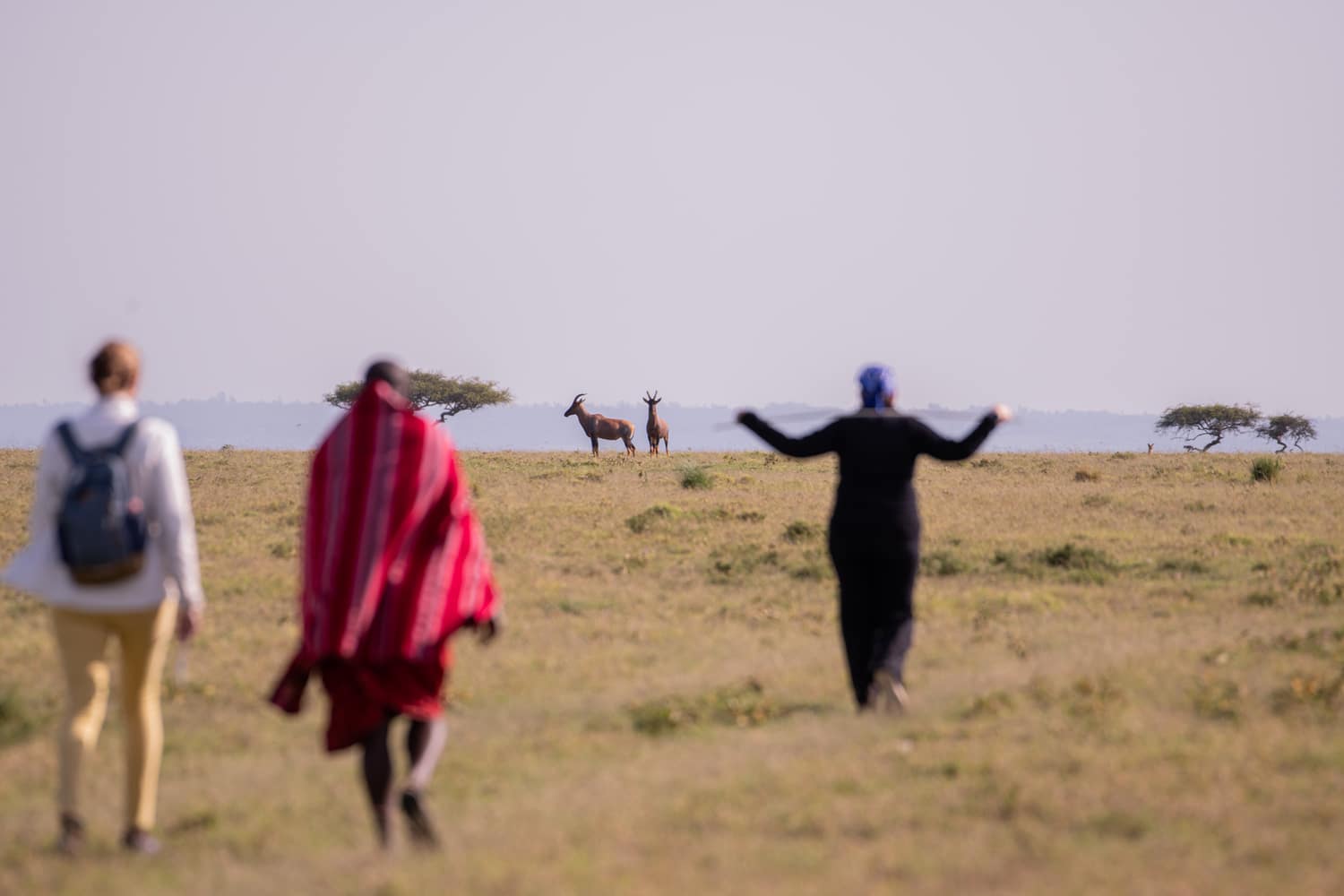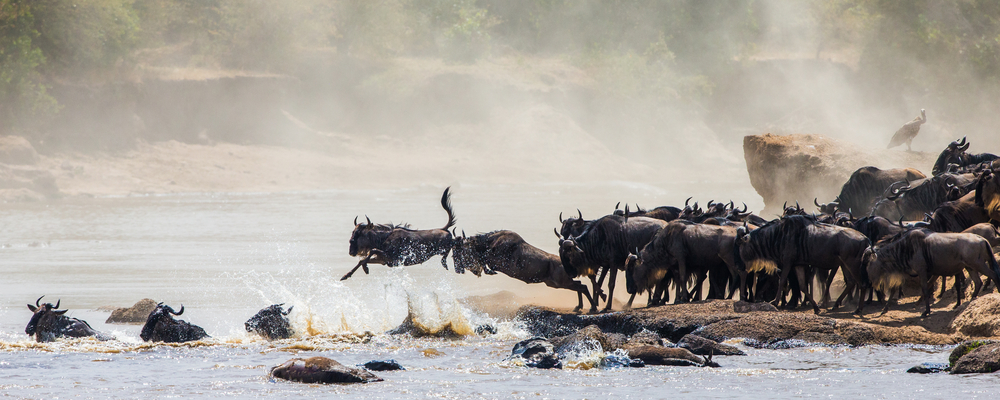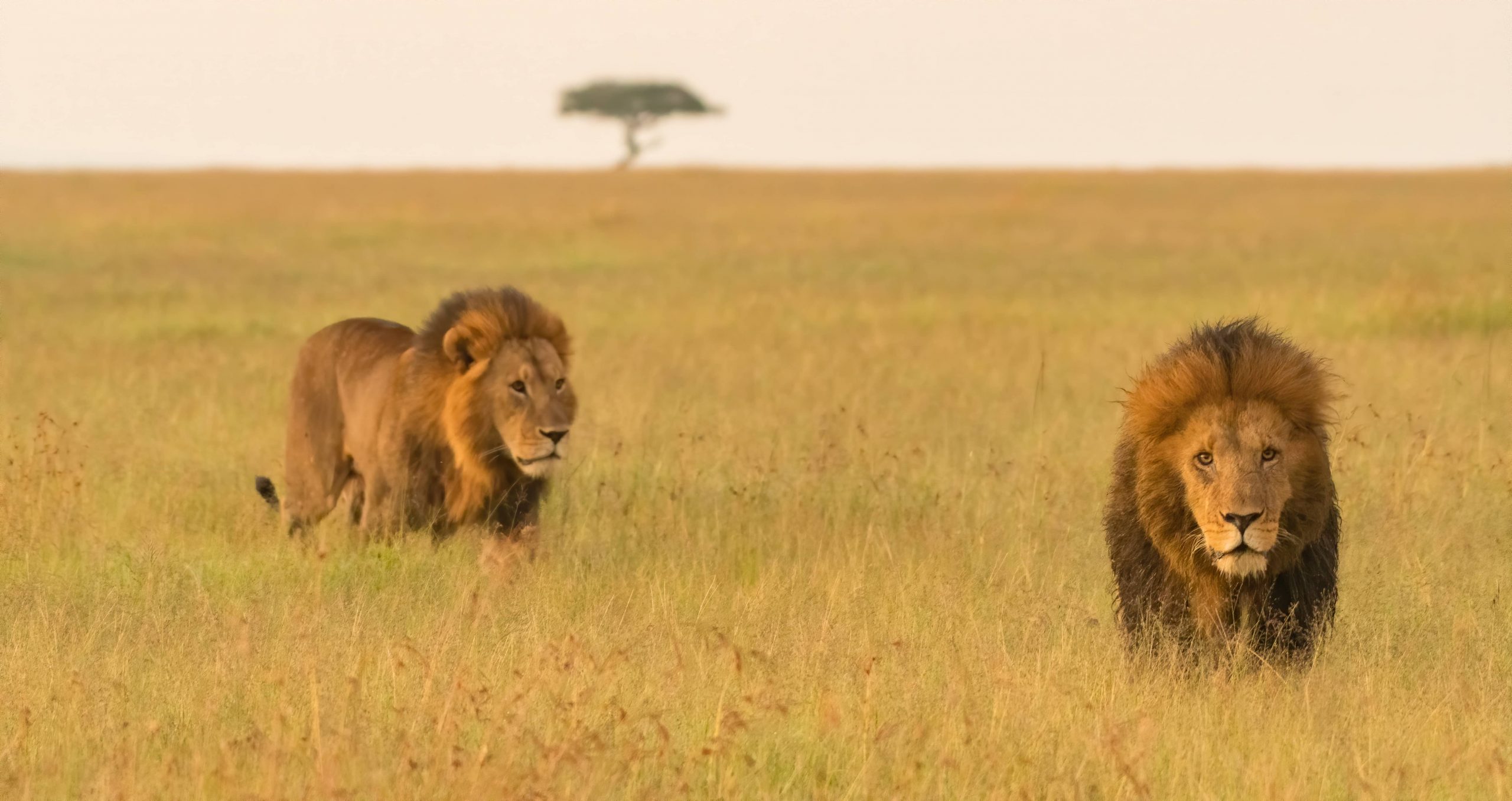Watching the great migration in Kenya is one of the most impressive natural phenomena in the world. This annual event attracts thousands of tourists and nature lovers eager to witness the majesty of wildlife at its best. At Trip to Help, we are excited to offer you the opportunity to see the great migration in Kenya in a responsible and sustainable way.
What is the Great Migration?
The great migration in Kenya is the mass movement of more than 1.5 million wildebeest, accompanied by hundreds of thousands of zebras and gazelles, which travel in a constant cycle between the Serengeti National Park in Tanzania and the Masai Mara National Reserve in Kenya. This journey, driven by the search for fresh grass and water, is a constant struggle for survival as predators such as lions, leopards and crocodiles seek their chance.
The great migration is also a crucial life cycle for the ecosystem. Migratory animals are not only a source of food for predators, but also play an essential role in fertilizing the soil with their feces, which helps maintain the health of grazing lands.
When and Where Does the Great Migration Take Place?
The best time to see the great migration in Kenya is between July and October, when the animals cross the Mara River in the Maasai Mara National Reserve. This crossing is one of the most dramatic and spectacular moments of the migration, as wildebeest and other species face death as they attempt to cross the river filled with giant crocodiles.
We have a private space in the Mara National Reserve and there we set up a fly-camp to spend two days and try to see the animals crossing the Mara River.
Itinerary to see the Great Migration in Kenya
Day 1. On the way to Mara River
- Breakfast at Masai Eco Lodge in the Lemek Conservation Area (inside the Masai Mara and bordering the National Reserve).
- Departure after breakfast to Mara National Reserve.
- Arrival at National Reserve and Safari adventure.
- Lunch
- Afternoon Safari and Sunset Experience in the Masai Mara
- Dinner and Campfire at the Mobile Camp
Day 2. We witness the Mara River crossing before returning to our lodge.
- Early morning safari at sunrise, when the Mara is at its most stunning and tranquil.
- Breakfast
- Safari from breakfast until lunchtime.
- Lunch camping beneath an acacia tree in the heart of the wilderness, at one of the world’s most exquisite dining spots you’ll ever experience.
- Head back to our Eco Lodge in Lemek for dinner, a campfire, and time to reflect on all that we’ve experienced.
The main focus over the two days will be observing the spectacular wildebeest crossings at various points along the Mara River in the National Reserve.
To witness the Great Migration with us, simply send us a message on WhatsApp or an email, and we’ll provide you with all the details, including pricing and availability.
Details of the Kenya-Tanzania Migration Cycle
- January to March marks the beginning of the migration in Serengeti National Park, with female wildebeest giving birth to their young. This period, known as the “Calving Season,” is characterized by abundance but also vulnerability, as predators capitalize on the large number of easy prey.
- From April to June, the herds start their northwest movement towards the Masai Mara National Reserve. During this time, they cross the Grumeti River, facing threats from crocodiles and other predators.
- July to October marks the most spectacular phase of the migration, as the animals traverse the Mara River. Witnessing thousands of animals crossing the river, braving crocodiles and strong currents, is a truly breathtaking spectacle.
- From November to December, the herds commence their journey back south towards the Serengeti, in search of fresh, young grass for feeding, thus completing the annual migration cycle.

The Importance of Conservation
At Trip to Help, we strongly believe in responsible tourism. The great migration in Kenya is not only a spectacle to enjoy, but also an opportunity to contribute to the conservation of wildlife and the ecosystems that make this phenomenon possible. We collaborate directly with the Maasai community, who oversee and organize this entire activity. Your guide, William, is not only a Maasai leader but also an official National Geographic guide in the Masai Mara. Moreover, all proceeds from the safari directly support the education of hundreds of Maasai children residing in the Masai Mara area outside the Reserve.

Why Choose Trip to Help?
By choosing Trip to Help for your Great Migration adventure in Kenya, you are opting for an experience that respects and protects the local communities, who almost always see tourism pass you by without bringing anything between the locals and their territory. Our safaris are organized with an NGO led by a Maasai, which supports local communities. In addition, William is one of the best guides you can have, he has been an official guide for National Geographic in this Netflix documentary: The Light of Stories (season 2).
Unique Experiences with Trip to Help
We offer a variety of options to enjoy the great migration, from 4×4 vehicle safaris to guided hikes and hot air balloon flights. Each of these experiences will allow you to see the migration from different perspectives, guaranteeing an unforgettable adventure.

Book your safari to see the Great Migration in Kenya
Don’t miss the opportunity to witness the great migration in Kenya. Book your trip with Trip to Help and experience an unforgettable adventure that also helps local communities. Contact us via Whatsapp or email, to get more information and start planning your trip.
Conclusion
The great migration in Kenya is one of the most exciting experiences any nature lover can have. At Trip to Help, we offer you the opportunity to experience this phenomenon in a responsible and sustainable way. Travel with us, enjoy the best safari, adventurous and responsible with the Maasai and see the positive impact you have on the territory.
Other blog posts:
- Arusha National Park: complete safari guideLocated in northeastern Tanzania, between Kilimanjaro and Mount Meru, Arusha National Park is one of the least known parks in the country. Despite its relatively small size (137 km²), it offers an impressive variety of landscapes and wildlife, making…
- Mandatory travel insurance for travel to ZanzibarIf you are traveling to Zanzibar or have plans to go there soon, this is of interest to you. The local government has announced that all tourists entering Zanzibar from October 1, 2024, will be required to take out…
- Seeing the Great Migration in Kenya: An Unforgettable Natural SpectacleWatching the great migration in Kenya is one of the most impressive natural phenomena in the world. This annual event attracts thousands of tourists and nature lovers eager to witness the majesty of wildlife at its best. At Trip…
- TRIP TO HELP, WINNER OF THE AFRICA WTM RESPONSIBLE TOURISM AWARDSTrip to Help, the online agency for responsible and regenerative travel, born in Barcelona, receives in its second year of life the the most outstanding recognition, the GOLD award, from the prestigious World Responsible Tourism Awards, held within the…
- Our visit to Lake Natron in TanzaniaLake Natron (Lake Natron), in northern Tanzania, is one of the most mysterious places in Tanzania. Its reddish color, its volcanic landscapes and its flamingos, make it an ideal destination to get away from the classic 5-day safari in…
- How much does a Kenya Safari Cost?Going on safari in Kenya is a unique trip in the world, and although nowadays there are cheaper alternatives, it is still expensive and not suitable for all budgets. How much does it cost to go on safari in…
- Original Maasai Lodge: An example of sustainable lodgingThe Original Maasai Lodge is a very special lodge, ideal if you are looking for an exclusive and different place, but that at the same time dedicates all its profits to social projects. Located in front of Kilimanjaro, and…
- How to make a sustainable trip to Kenya: Tips & TricksADCAM’s accommodation in the Maasai Mara, a sustainable lodge for a sustainable trip in Kenya.
- Sustainable Safari in TanzaniaWhen we travel to Tanzania for a safari, we have a moral and ethical responsibility to try to make it as sustainable as possible. In a safari, as in most trips, we can decide what kind of impact we…
- Sustainable Travel in TanzaniaTanzania is a destination that receives many tourists every year, thanks to breathtaking natural landscapes, abundant wildlife, safaris in world-renowned national parks, and idyllic beaches. In 2019, Tanzania welcomed 1.5 million international tourists and aims to increase this number…
- Money in Kenya: tips and tricksToday, I’m going to share some money tips and tricks for traveling to Kenya. How much cash should I bring? What currencies are accepted in Kenya? Are ATMs readily available? Can you use a credit card in Kenya? These…
- Money in Tanzania: practical tips for traveling to TanzaniaIn this article I will answer many of the questions travelers ask us before traveling: Money in Tanzania . What money should I bring to Tanzania? Is it better to bring cash from Spain or take it out there?…
- What is the best time to travel to Kenya?Kenya is one of Africa’s top destinations. If you have come this far, you are planning to go on safari in Kenya or get to know the life of the Maasai tribes. We want the trip to be unforgettable…
- Going on a Safari with Kids: Is It Recommended?Is it a good idea to go on a safari with kids? This is one of the most common questions we hear from families eager to explore the magic of Africa with their children. Our answer is a yes!Going…
- Kenya or Tanzania Where is the best safari?When we want to go on safari, we always ask ourselves the best country to go on safari: Kenya, Tanzania, South Africa? There are several countries where we can do a safari. In this post in particular we are…
- Our Kenya Safari ExperienceWe really wanted to go on safari in Kenya, and besides, it was the first time we traveled having launched Trip to Help. In addition to enjoying ourselves, we had our sights set on analyzing what we were going…
- The best travel insurance for Tanzania: Chapka or IATI? – 2024If you want to go to Tanzania and you want to take out travel insurance to cover you for any unforeseen event, illness, loss of luggage, you will need a good travel insurance that will cover you for all…
- 10 days in Zanzibar: For independent and first time travelersZanzibar is the ideal destination after a few days of safari, Maasai culture and nature walks in Tanzania. In this post we explain you how we lived our trip, and we make you a list of must-see in Zanzibar…
- 5-day safari in TanzaniaOn our honeymoon trip to Tanzania we knew we wanted to go on safari. We studied all the options and in the end we decided to go on a Safari of 5 days in Tanzania. Differences between a 5-day…
- Getting around in ZanzibarIn this post we explain you how to get around in Zanzibar (on your own). We have been there, and we assure you that it is comfortable, it is not difficult, it is safe, and it also allows you…
















